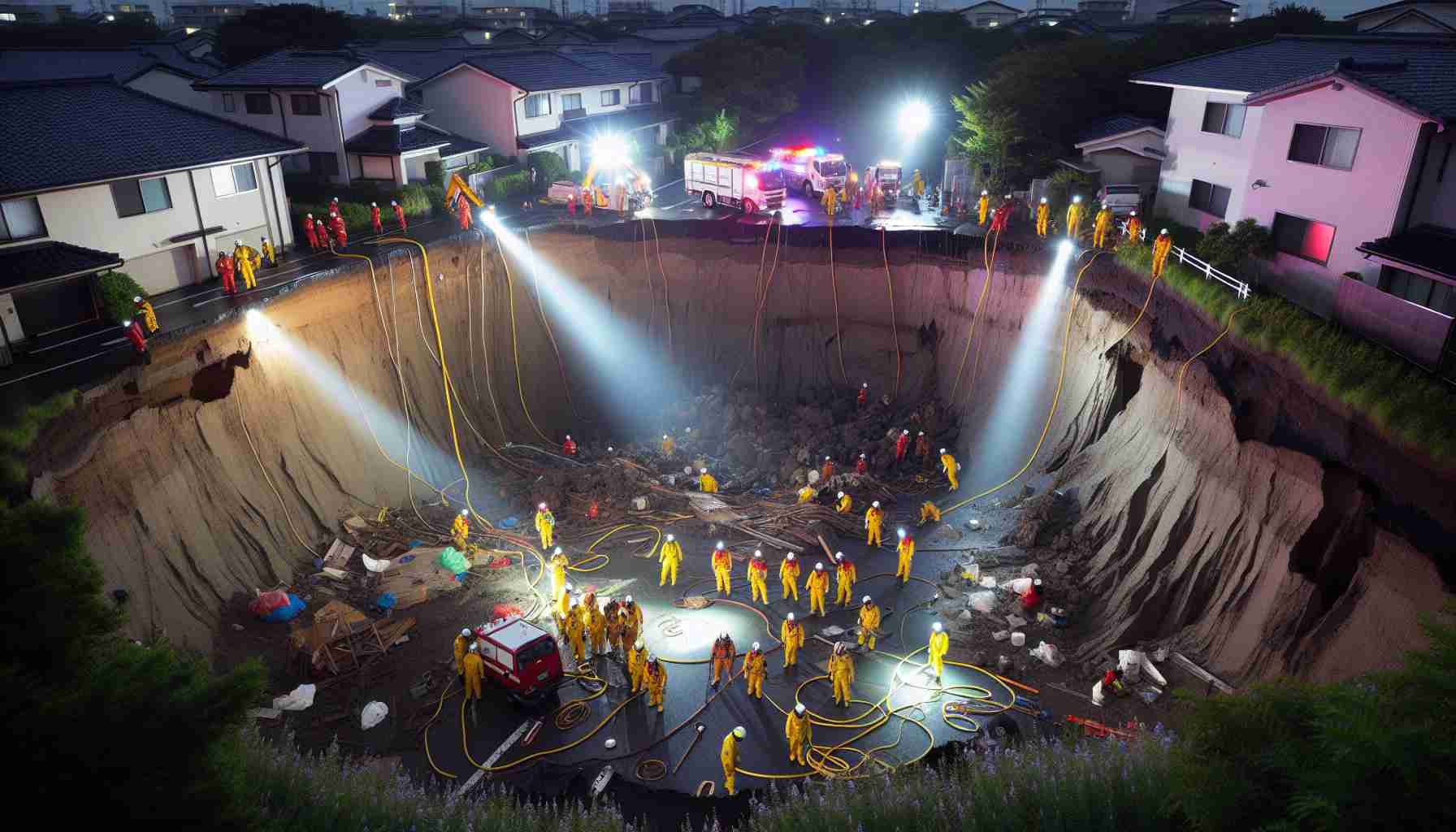- A truck and its elderly driver fell into a 15-meter sinkhole in Yashio City due to a sudden road collapse.
- Rescue teams are working to save the driver, constructing a 30-meter ramp for access.
- Operations were temporarily halted due to an influx of water and potential weather conditions.
- The ramp was carved from a restaurant’s parking lot to aid multiple machines and responders.
- Downed power poles and road infrastructure complicate the rescue efforts.
- Experts are considering recovery strategies amid concerns of small-scale landslides.
- Highlighting the importance of infrastructure resilience in the face of extreme weather patterns.
In a gripping scene unfolding in Yashio City, Saitama Prefecture, a sudden road collapse has sent a truck, along with its elderly driver, plummeting into a gaping 15-meter hole. As rescue teams scramble to save the trapped man, heavy machinery has been deployed to construct a sturdy 30-meter ramp to facilitate the operation.
Just before noon, workers began removing debris from the sinkhole, revealing a complex web of mud and concrete. Despite progress, the situation remains precarious; a sudden influx of water forced operations to pause until the following day. Authorities are cautiously eyeing conditions, bracing for possible rain or snow that could exacerbate the disaster.
The construction of the ramp wasn’t without its challenges. With a width of four meters, the slope was expertly carved out from a nearby restaurant’s parking lot, allowing multiple machines to access the pit and clear away rubble while dozens of responders worked tirelessly within the void.
Adding to the complexity, downed power poles and remnants of the road’s infrastructure litter the site. As experts gather for urgent discussions on recovery strategies, alarms are raised about ongoing small-scale landslides threatening further chaos.
This harrowing rescue operation underscores the unpredictable nature of such disasters. As emergency services take every precaution, the local community watches anxiously, hoping for a safe and swift resolution. The key takeaway? Infrastructure resilience is vital, especially as extreme weather patterns become more common.
Shocking Road Collapse in Yashio City: Rescue Operations Underway!
Overview of the Incident
In a dramatic turn of events in Yashio City, Saitama Prefecture, an unexpected road collapse has resulted in a truck and its elderly driver falling into a 15-meter deep sinkhole. Emergency responders are mobilizing intensely to rescue the trapped individual amidst challenging weather conditions and precarious site stability.
Key Details of the Rescue
Rescue teams are working diligently amid a complex scenario. Heavy machinery is at the forefront, with the construction of a robust 30-meter ramp designed to facilitate the extraction of the truck. However, their efforts have been thwarted by a sudden surge of water, causing work to halt until conditions improve. As workers clear debris, they are met with a tangled mass of mud and concrete, further complicating rescue operations.
Current Challenges:
– Weather Concerns: With forecasts predicting possible rain or snow, conditions on-site may worsen, complicating the ongoing efforts.
– Infrastructure Damage: The area is complicated by downed power lines and remnants of the damaged roadway, necessitating careful navigation and prioritization of safety.
New Insights and Trends
1. Infrastructure Resilience Trends:
– This incident highlights a growing need for improved infrastructure resilience in urban areas, especially as climate change intensifies extreme weather events.
2. Emergency Preparedness Impact:
– The effectiveness of emergency preparedness and response systems is being scrutinized, prompting discussions about mitigation strategies for urban infrastructure.
3. Expansion of Rescue Technologies:
– Innovations in rescue technology, such as drones and remote sensing tools, are being explored to enhance situational awareness during rescue operations.
FAQs
1. What caused the road collapse in Yashio City?
The road collapse appears to be linked to complex geological conditions exacerbated by recent weather patterns, including localized heavy rains which may have softened the soil structure.
2. How long might rescue operations take?
While it’s difficult to predict, responders are working as quickly and safely as possible. Factors such as weather conditions and site stability will heavily influence the duration of the rescue efforts.
3. What safety measures are in place for rescue teams?
Emergency services are prioritizing the safety of their personnel by employing stringent protocols, including site assessments, use of personal protective equipment, and constant monitoring of environmental conditions.
Conclusion
This distressing incident serves as a crucial reminder of the vulnerabilities present in urban infrastructure and the necessity for robust disaster preparedness strategies. With the future of the trapped driver at stake and the community holding its breath, the outcome of this rescue operation is eagerly anticipated.
For more on emergency response strategies and infrastructure resilience, visit NBC News.

















